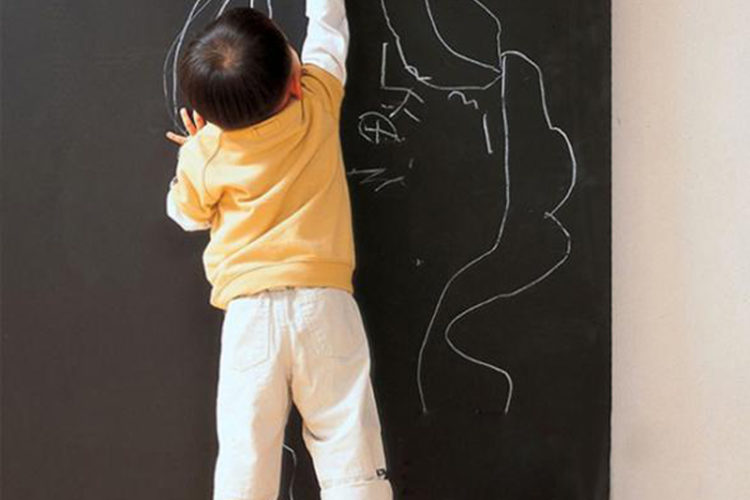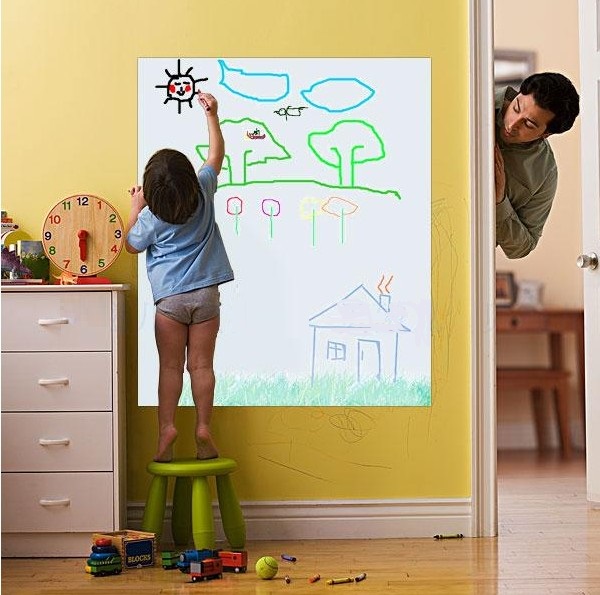Back when I was in school, I never thought about the developmental benefits of writing and working on the vertical surface of the chalkboard, but as a therapist, now I know that there are many! The occupational therapists I work with encourage children to work on vertical surfaces all the time and here’s why…
1 Shoulder/Elbow Stability
The use of larger vertical surfaces such as chalkboards, marker boards, and Smart boards allows children to use bigger arm movements that encourage strength and flexibility throughout the joints and muscles of the upper extremities. Even the hand gets a hefty boost of strengthening as it works against gravity to keep making vertical, horizontal and diagonal lines.
2 Bilateral Coordination
Have you ever tried to use a stencil while working on a vertical surface? I once tried to stencil a pretty fleur de lis pattern on a wall — it was a disaster! This is a tough skill! For kids, tracing an object, using a stencil, or even just stabilizing their paper to write on an upright surface requires the use of both hands (one to trace, one to hold) AND it requires proprioception and strength to hold the object that is being traced!
3 Midline Crossing
When a child is writing or drawing across a large vertical surface, he has to cross the midline of his body with his dominant hand to reach all of the spaces. This is great practice for children who are struggling with midline crossing and establishing a strong hand dominance.
4 Wrist Extension/Pencil Grasp
Vertical surface writing naturally puts the wrist in an extended position which encourages hand stabilization for better pencil grasp and control of writing utensils.
5 Visual Attention and Hand-Eye Coordination
Working on a vertical surface brings the task closer to the child’s eyes. This helps kids who have difficulty maintaining visual attention to activities and can help to encourage hand-eye coordination, as the child has a better view of what they are doing!
6 Spatial Awareness
When a child works on a large vertical surface, it makes directional terms (up, down, left, right) much easier to understand because the child can relate the words to his very own body!
7 Sensory Motor skills
Working at a vertical surface may be beneficial for fidgety kids who work better in a standing position than sitting at a desk. Let’s face it, we all work better if we can change positions!
8 Core Strength and Posture
Working in a kneeling or standing position at an upright surface gives kids a good dose of core strengthening. There’s no slumping or leaning on the back of the chair – the only choice is to engage those core and back muscles to maintain upright posture!
Vertical Surface Activities
There are tons of fun ways to play and work using a vertical surface. Here are some of our favourites:
-Play with stickers! Have the child stick them all over the wall at different levels and then give him directions for which stickers to touch – he may have to jump or bend!
-Make your own DIY Removable Lego Wall! Building with Legos on a vertical surface? Not only super fun, but also great for all of the skills listed above!
-Tape a piece of paper to the wall and trace objects or stencils
-Paint with paintbrushes or paint rollers
-Decorate a window with window clings
-Play with magnets on the refrigerator
-Paint with shaving cream or finger paint on an easel
-Play with felt shapes and pictures on a felt board
-Draw and colour with chalk on a chalkboard
-Writing with dry erase markers or window markers on a window or hanging mirror
-Writing/drawing activities on a Smart board
-Writing and drawing with bath foam or bath crayons in the tub
-Prop iPads and other tablets up using a slant board or the prop that comes on the case. Let kids use a stylus to encourage use of an efficient grasp.
-Wash windows and using a squeegee
-Help wash the car
-Erase a chalkboard or wipe down a marker board
-Try any of the above in kneeling, standing, or while seated
This article was first published by The Inspired Treehouse in June 2015, by Lauren Drobnjak

